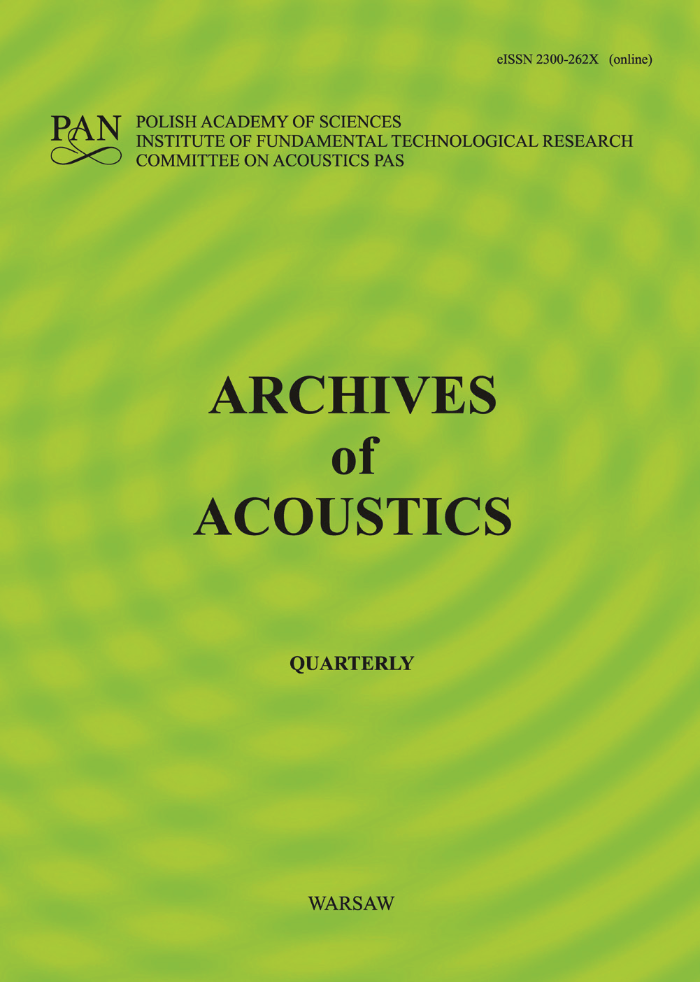Analysis and Optimization of Micro Speaker-Box Using a Passive Radiator in Portable Device
Abstract
With the rapid development of multimedia devices such as smart phones and tablet PCs, microspeakers have been recently increasingly used for audio equipment. Improving the acoustic performance of a microspeaker is always a main concern, especially in the low frequency range. To avoid sound cancelation, a microspeaker unit is usually inserted into a speaker box. A passive radiator is also used in speaker boxes to improve the sound performance in the loudspeaker system. However, passive radiators have not been applied into microspeaker system. In this study, a speaker box with a passive radiator was analyzed and optimized to achieve a higher Sound Pressure Level (SPL) in a microspeaker system. The Finite Element Method (FEM), two-degree-of-freedom (DOF) vibration theory, and a plane circular piston sound source were used to study the electromagnetic, vibration, and acoustic characteristics, respectively. Optimization was conducted by changing the mass, stiffness, and size of the passive radiator. Based on the optimized parameters, a new sample was manufactured. The experiment results show that the SPL of the optimized speaker box with a passive radiator is improved by 5 dB at 200 Hz compared with the one without a radiator. The analysis results also matched the experiment results.Keywords:
passive radiator, speaker box, SPL improvementReferences
1. Xu D.P., Sun P., Kwon J.H., Hwang S.M. (2014), An integrated design of microspeaker module with smaller volume, Journal of Applied Physics, 115, 17A339, https://doi.org/10.1063/1.4868183.
2. Sun P, Xu D.P, Hwang S.M. (2014), Design of microspeaker module considering added stiffness, Journal of Mechanical Science and Technology, 28, 5, 1623–1628.
3. Leach W.M. (2003), Introduction to electroacoustics and audio amplifier design, Kendall/Hunt Publishing Company.
4. Small R.H. (1974a), Passive-radiator loudspeaker systems. Part 1: Analysis. Journal of the Audio Engineering Society, 22, 592–601.
5. Small R.H. (1974b), Passive-radiator loudspeaker systems. Part 2: Synthesis. Journal of the Audio Engineering Society, 22, 683–689.
6. Rao S.S. (2004), Mechanical vibrations, 4th ed., Pearson Education, Upper Saddle River.
7. Kinsler L.E, Frey A.R, Coppens A.B, Sanders J.V. (1999), Fundamentals of acoustics, 4th ed.,Wiley-VCH.
8. Klippel W, Schlechter J. (2010), Dynamical measurement of the effective radiation area SD, Proceedings of 128th Audio Engineering Society Convention, London, Vol. 1, pp. 568–577.
9. Paul C.R., Nasar S.A. (2001), Introduction to electromagnetic fields, 3rd ed., McGraw-Hill.
2. Sun P, Xu D.P, Hwang S.M. (2014), Design of microspeaker module considering added stiffness, Journal of Mechanical Science and Technology, 28, 5, 1623–1628.
3. Leach W.M. (2003), Introduction to electroacoustics and audio amplifier design, Kendall/Hunt Publishing Company.
4. Small R.H. (1974a), Passive-radiator loudspeaker systems. Part 1: Analysis. Journal of the Audio Engineering Society, 22, 592–601.
5. Small R.H. (1974b), Passive-radiator loudspeaker systems. Part 2: Synthesis. Journal of the Audio Engineering Society, 22, 683–689.
6. Rao S.S. (2004), Mechanical vibrations, 4th ed., Pearson Education, Upper Saddle River.
7. Kinsler L.E, Frey A.R, Coppens A.B, Sanders J.V. (1999), Fundamentals of acoustics, 4th ed.,Wiley-VCH.
8. Klippel W, Schlechter J. (2010), Dynamical measurement of the effective radiation area SD, Proceedings of 128th Audio Engineering Society Convention, London, Vol. 1, pp. 568–577.
9. Paul C.R., Nasar S.A. (2001), Introduction to electromagnetic fields, 3rd ed., McGraw-Hill.






